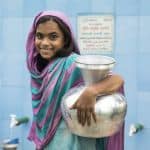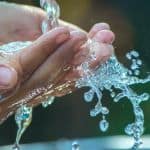Microfinance for Water and Sanitation: Opportunities and Challenges for MFIs
Access to safe and affordable water, sanitation and hygiene (WASH) infrastructure and services is essential to quality of life. However, globally, 2.4 billion people do not have access to improved sanitation facilities and 663 million do not have access to safe drinking water. Consequently, one of the UN Sustainable Development Goals, No. 6, is to achieve universal and equitable access to safe and affordable drinking water and adequate and equitable sanitation and hygiene for all by 2030. The World Bank estimates that US $1.7 trillion is required to meet these targets, and public finance by itself will not be enough, meaning private investments or innovative financing approaches like WASH microfinance are needed.
Why microfinance for WASH financing?
For low-income households, accessing WASH infrastructure is not cheap. MicroSave research shows that, in parts of Asia, building private toilets can cost up to $400 for a household, while piped water connections cost around $150. Second, the poor have more salient priorities like education and health that tend to consume their liquidity, so WASH improvements that require “lumpy investments” take a back seat. Interestingly, credit products offered by most microfinance institutions (MFIs) fall in the sweet spot of WASH investments. Globally, MFIs have honed the systems and processes to offer credit in the range of $100 to $500, and repayments are staggered over a period of six months, a year or even longer.
While research shows that market potential for microfinance in water and sanitation is quite large, can this be transformed into a sustainable business opportunity for MFIs? WASH finance differs significantly from productive loans; since these loans do not generate visible income streams, there are several strategic/operational issues that determine the suitability of a WASH finance product. Some of the key points include:
Ecological factors and presence of WASH public infrastructure: Favourability of some key “hydro-geological” factors like land gradient, thickness and quality of topsoil, availability of proximate water sources, etc., have a direct bearing on the uptake of WASH equipment and services. For instance, if an MFI provides credit for constructing toilets in a region with chronic shortage of water, it will be only a matter of time before the client relapses into the habit of open defecation. Similarly, availability of public WASH infrastructure like sewer lines or main pipelines for water favourably influence pickup of WASH services. MFIs need to carefully select the geographies where they are more likely to succeed.
Existing awareness and level of usage of existing WASH infrastructure: MicroSave’s customer research shows that WASH facilities are in most demand when the existing infrastructure is in active use. We found that in villages where a sizeable population is using sanitation facilities (either private or community), the demand for toilets tends to be high. The reasons were easy to understand: As usage increases, adverse public opinion about open defecation gathers strength and, over time, more and more households build their own toilets. Thus, people are more likely to access finance to upgrade and acquire WASH systems in an environment which induces them to do so.
Collaborations with WASH product/service providers: In several geographies there are existing WASH product manufacturers and service providers who are unable to tap into the low-income segments due to high upfront costs. MFIs can collaborate with such entities and leverage the existing market demand for these services. For instance, SMEP, an MFI in Kenya, has collaborated with water tank manufacturers to provide loans for water storage structures. Similarly, Bank Syariah Mandiri, a commercial bank in Indonesia, offers loans for piped water connections from the local public water supply agency.
Availability of long-term funding for WASH: MFIs in many countries depend on debt funding from banks and financial institutions for financing their portfolio, but these funds are restricted to “income generating/productive activities.” Asset-liability mismatch is another issue; an MFI that gets a shorter-term loan exposes itself to liquidity risk if it were to offer a WASH loan that is typically of a longer tenure. MFIs may have to look for more tailored sources of funds or explore social investors/patient capital to raise funds for WASH finance.
Technical capacities to assess WASH infrastructure: MFIs must have access to technical capacities to understand the feasibility of setting up WASH infrastructure (groundwater levels, availability of public sewerage facilities, etc.) and the type of products available in the market to fulfill different WASH needs. While in-house capacities may be limited, it can be helpful to engage external agencies. Understanding these aspects will help the MFI design tailor-made products and also enter into service contracts with WASH manufacturers and service providers.
Customer education and awareness are key for product marketing: The importance of customer education and awareness generation is a key ingredient for product uptake. For example, increased awareness on the adverse health impacts of impure water or open defection can lead to greater adoption of water filters and/or hygienic toilets. Partnerships with NGOs can be a useful strategy to implement such information campaigns. Grameen Koota, an Indian MFI, works with an NGO, Navya Disha, to generate awareness amongst its customers before moving in with financial products to support WASH activities.
In summary, WASH presents an exciting opportunity for MFIs to meaningfully impact their customers’ lives and aid in their struggle against poverty. However, to tap into this opportunity in a sustainable way, MFIs have to factor in the aforementioned issues. To help them navigate through these, MicroSave, together with Water.Org, has developed a series of toolkits for MFIs to develop and manage WASH finance products. The toolkits draw on successful WASH finance programmes and give lots of practical examples and detailed guidelines on various aspects of managing a WASH finance programme.
T.V.S Ravi Kumar is a senior manager in MicroSave’s Country Development Programme Indonesia. Anant Jayant Natu heads the central operations department at Arohan.
Photo by Rod Waddington via Flickr
- Categories
- Health Care




